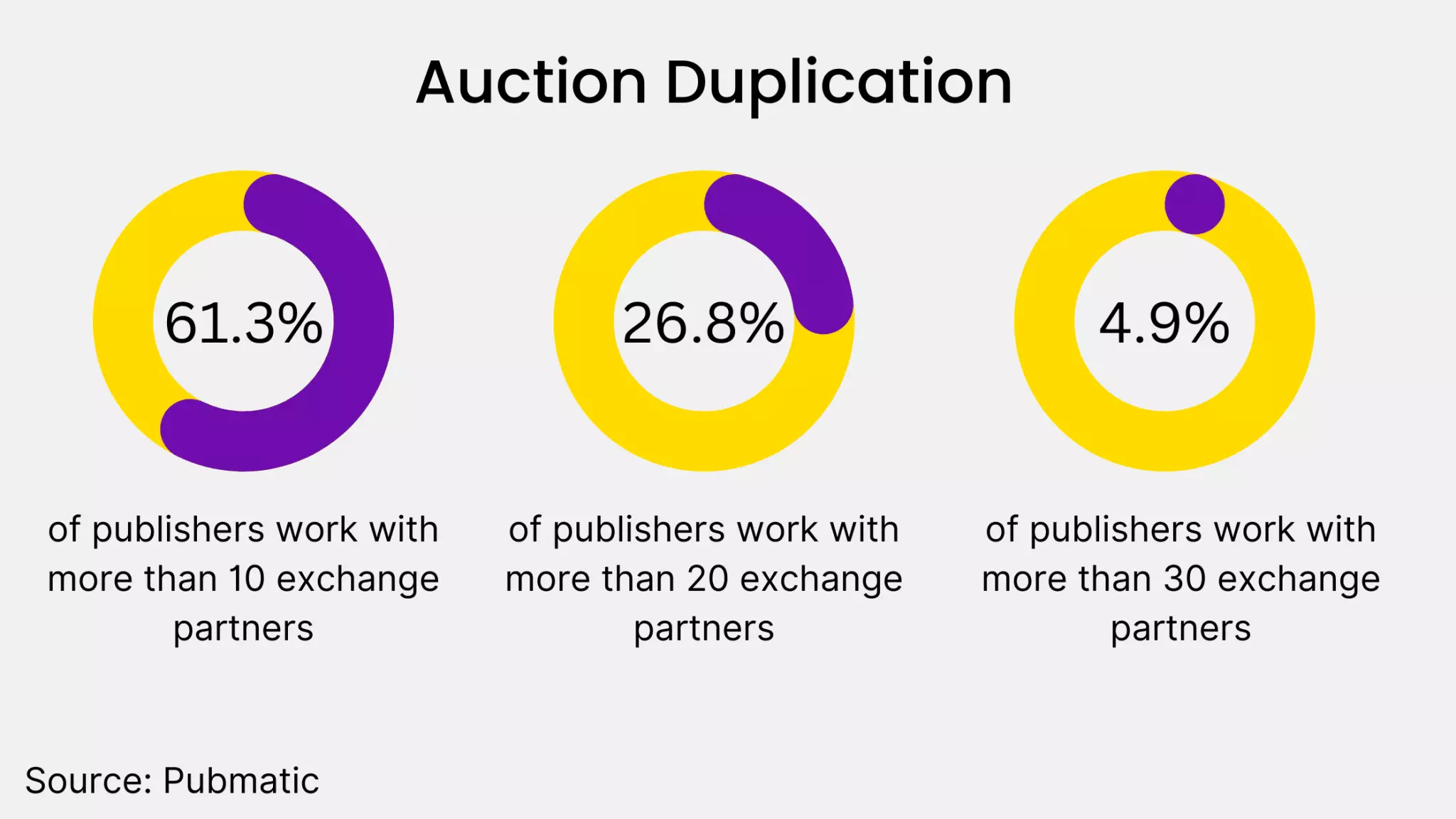Let’s say you are buying a book online. You check the price on two different websites and find out that the price is the same on both, but the delivery fees vary by 30%. There can be many reasons behind the difference in the delivery charges — longer routes, transportation fees, the involvement of too many transportation providers, or anything else.
Do you care about all these factors? The website that can fulfill both conditions gets your order. Like the website, you’re selling your ad inventory to advertisers.
The selling process also follows a route — known as the ‘Supply Chain’, and the cost of the ad also depends on the route. Do you want to ensure an efficient path, fewer intermediaries, and fewer fees for the buyers? Definitely yes. But how can it be done? The answer is Supply Path Optimization.
Ad tech is an ever-evolving industry, and Supply Path Optimization (SPO) is the new evolution. 87% of brands, agencies, and DSPs actively engage in SPO. At its essence, SPO is an effort to weed out the problem of auction duplication. Still, it can bring many benefits to publishers and their inventory buyers by solving a single problem. Let’s dive deeper.
Table of Contents
Understanding Auction Duplication
Header bidding brought an unprecedented scale to programmatic advertising. The buyers and the sellers can work with numerous partners to fulfill their demands and supplies. As per Pubmatic’s survey, almost 60% of publishers work with more than ten exchange partners. But the same scalability also became the reason behind auction duplication.

Let’s try to understand a simplified example of auction duplication. The advertiser buys the inventory through ad exchanges A, B, and C. The same exchanges are connected to a single publisher like you. So, ultimately the buyer is bidding for the same ad impression through three different supply paths and competing with itself.
“The average impression in programmatic has been auctioned 15 times before an ad is ultimately served,”
– Ari Lewine, Chief Strategy Officer, TripleLift
Why doesn’t the buyer stop using two ad exchanges and solve the problem? If the buyer cuts off two exchanges, he will eliminate the duplicate and unique supply from those exchanges. But why should you care about SPO? Read on.
What Is Supply Path Optimization (SPO)?
It is a process, typically from the demand-side platforms, via which multiple variables are assessed to drive buyers toward the most efficient buying path.
Long answer:
IAB’s definition of SPO focuses on the buyer. It defines SPO as
‘A process in which multiple variables are assessed to drive buyers towards the most efficient buying path.’
In our example above, the advertiser is facing a loss because of the redundant supply paths. Any effort to improve and optimize this inefficient supply path to reduce the buyer’s loss can be called supply path optimization.
But this looks like an advertiser’s problem. Furthermore, the publisher benefits from the inefficient path because the same advertiser is trying to outbid himself. So why should a publisher care about SPO?
Why Should Publishers Care About SPO?
While auction duplication looks beneficial in the short term, advertisers will eventually stop buying (or at least block some routes) from publishers who send duplicate requests. DSPs are already using algorithms to analyze the requests before placing their bids. The algorithms help advertisers to skip redundant bid requests.
This process will become more and more common as the awareness and efforts towards SPO keep increasing. On the other hand, advertisers will prefer to buy inventory from a publisher who can provide an optimized path. So, publishers have an opportunity to attract more demand.
Why Is SPO Needed?
SPO has many benefits for the publishers as it is needed to
- Eliminate unnecessary expenses,
- Bring transparency,
- Reduce ad fraud,
- Better ROI, etc.,
Transparency: The ad tech industry lacks transparency, and supply chain optimization tries to improve it. The best example of the issue is Adweek, which revealed that 98% of advertisers’ spending reaches advertising vendors instead of publishers.
Why?
Because the route of an ad from the advertiser’s ad server to the publisher’s ad unit is so complicated that keeping track becomes next to impossible. Had the process been more transparent, improving it would have been possible so that more ad spend could reach the publisher?
Fees: Commissions and fees are directly proportional to the players who deliver the ad from the advertiser to the publisher. Publishers get only the remaining ad spend because there are too many supply-path parties. DSPs, SSPs, resellers, ad exchanges, and networks each take their fees for facilitating the process. A high number of participants means a high cost.
“They normally filter most of the bids and send us only those with the highest probability to win. This technology saves us huge money on server cost.”
– George Levin, CEO, Getintent
Revenue: Advertisers bid only for the most relevant ad inventory when using algorithms for SPO. It improves fill rates and the win rate. Eventually, the cost comes down for the advertiser. In the long term, when an advertiser saves money, it reinvests the amount to get more returns. Ultimately, the advertising budget reaches publishers like you. An optimized path will ensure you receive larger chunks of the investment and reinvestment. Hence, SPO means better revenue for you.
Ad fraud: Shorter supply paths with limited and trusted players reduce the likelihood of ad fraud. It is easier for fraudsters to dupe the system when the supply path is long and the number of involved parties is high. It won’t be surprising if many of the unattributed ad spends in the Adweek report falls prey to ad fraud.
How Is Supply Path Optimization Taking Place?
As we said earlier, any efforts made to reduce the inefficiencies of the supply path are SPO. Anyone can make these efforts, be it an advertiser, a publisher, an SSP, a DSP, or any other party in the ad tech ecosystem. Here are some industry initiatives toward supply-path optimization:
Ads.txt is a text file on the publisher’s website that lists all advertising partners authorized to sell the inventory. The advertiser can ensure he is buying the inventory from a legitimate source by verifying the ads.txt file. It prevents illegitimate reselling of the publisher’s ad space. You can read more about the file here.
Sellers.json: It is the SSP’s version of the ads.txt file. It lists the resellers authorized by the SSPs. The sellers.json, too, prevents the unauthorized sale of the inventory.
Removing aggressive SSPs: While solutions like ads.txt and sellers.json are industry standards, ad tech companies are doing SPO at their level. Xandr (formerly known as AppNexus) tries to weed out SSPs that are costlier than others. It stops buying from the SSPs as soon as it spots the difference.
As the number of intermediary SSPs decreases, the advertiser sees better results from the publisher. Advertisers shift their ad spending towards publishers that yield better results.
Using a single path: Avoiding multiple routes to buy or sell the inventory is one of the most potent ways to implement SPO. Recently, The Trade Desk asked its SSPs to choose a single supply path to premium inventory. There’s no chance of auction duplication when there’s only one path. The DSP’s operational cost comes down as it has fewer bid requests to process. The process becomes more transparent, the advertiser saves money, and more money reaches the publisher.
The Current State of Supply Path Optimization
SPO is becoming one of the top priorities of the industry. As per Integral Ad Science’s report,
60% of the buyers actively implemented SPO strategies to purchase an impression, whereas 95% would boost their SPO efforts to find the most effective SSP path to the publishers in 2022.
The significant objective for the buyers is to reduce the fees.
With so many benefits, SPO is bound to attract much attention in the ad tech industry.
What Should You Do?
The advertisers, DSPs, SSPs, and all the other players in the industry are doing SPO as per their capacities. You can do the same. Here are some suggestions for you:
- Ensure that you are using ads.txt on your website. Always keep it updated so that the buyers can verify your partners.
- If you have a managed header bidding provider, let them handle the demand. Adding more and more resellers isn’t going to bring in exclusive buyers; it just adds up to duplication.
- Make sure your header bidding providers take any measures to prevent duplicate demand.
- While adding a reseller, find out whether it brings unique demand. For instance, working with an MCM partner makes sense if you do not have access to AdX.
- Observe the long-term performance of your SSPs. It’s better to stay away from constantly underperforming ones. Doing so will reduce the chances of sending duplicate requests without risking a significant part of your revenue.
The Future of Supply Path Optimization
The SPO movement will keep gaining heat because of rising complexities in the ad tech industry. The buyers will push for a direct and short route for their ads. Publishers with unique and premium supplies will always have the upper hand in the game. If your inventory is in demand, the advertisers will find ways to reach it. The buyers will prefer you more when you can offer your inventory through an optimized path.
But SPO is not the end of the story. There’s another similar trend, called demand path optimization (DPO), approaching the industry. It will help publishers prevent their ad inventory from selling at less than optimum rates. While SPO starts from the advertiser’s end, DPO starts from the publisher’s. Read more about it here.
FAQs
What Is Supply Path Optimization?
Supply Path Optimization (SPO) is a buzzword in the programmatic advertising industry that refers to optimizing the path through which ad impressions are bought and sold. It is a process of selecting the most efficient and transparent supply chain that connects advertisers with publishers while eliminating any unnecessary intermediaries or “middlemen” along the way.
What Are the Benefits of Supply Path Optimization?
The benefits of Supply Path Optimization (SPO) include reduced costs, improved transparency, higher viewability, and brand safety, better-increased revenue for publishers, and improved overall performance.























